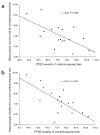Smaller hippocampal volume predicts pathologic vulnerability to psychological trauma
- PMID: 12379862
- PMCID: PMC2819093
- DOI: 10.1038/nn958
Smaller hippocampal volume predicts pathologic vulnerability to psychological trauma
Abstract
In animals, exposure to severe stress can damage the hippocampus. Recent human studies show smaller hippocampal volume in individuals with the stress-related psychiatric condition posttraumatic stress disorder (PTSD). Does this represent the neurotoxic effect of trauma, or is smaller hippocampal volume a pre-existing condition that renders the brain more vulnerable to the development of pathological stress responses? In monozygotic twins discordant for trauma exposure, we found evidence that smaller hippocampi indeed constitute a risk factor for the development of stress-related psychopathology. Disorder severity in PTSD patients who were exposed to trauma was negatively correlated with the hippocampal volume of both the patients and the patients' trauma-unexposed identical co-twin. Furthermore, severe PTSD twin pairs-both the trauma-exposed and unexposed members-had significantly smaller hippocampi than non-PTSD pairs.
Conflict of interest statement
The authors declare that they have no competing financial interests.
Figures



Comment in
-
Chickens, eggs and hippocampal atrophy.Nat Neurosci. 2002 Nov;5(11):1111-3. doi: 10.1038/nn1102-1111. Nat Neurosci. 2002. PMID: 12404003 Review. No abstract available.
References
-
- McEwen BS. In: The Cognitive Neurosciences. Gazzaniga MS, editor. MIT Press; Cambridge, Massachusetts: 1995. pp. 1117–1135.
-
- Squire LR. Memory and the hippocampus: a synthesis from findings with rats, monkeys, and humans. Psychol Rev. 1992;99:195–231. - PubMed
-
- Zola-Morgan S, Squire LR. Neuroanatomy of memory. Annu Rev Neurosci. 1993;16:547–563. - PubMed
Publication types
MeSH terms
Grants and funding
LinkOut - more resources
Full Text Sources
Other Literature Sources
